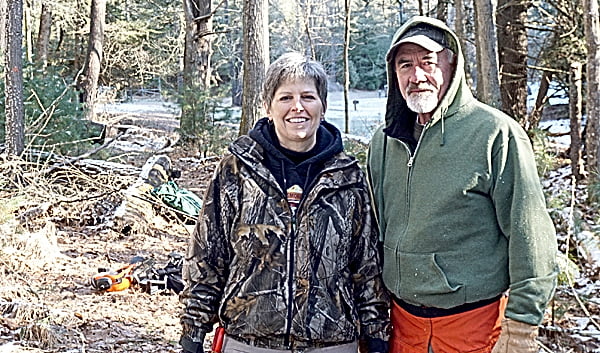
The Pulaski
A celebration of a tool
Trail workers tend to do a lot of talking when working on a team; sometimes about the mundane: “When is this d**n rain gonna stop?,” at other times about the arcane: “I just read a great article about Dark Energy and….” (to be honest, that one rarely comes up). So one day, when benching a Watoga trail on a steep hillside, one of the volunteers shouted down the line, “Hey, what’s that firefighting tool called that has an axe on one end of the head and a mattock on the other?”
I couldn’t remember but took a shot at it anyway.
“I think it is called a Kolache,” I shouted back.
Thirty feet back down the trail, Laura and Margot, clearing out some encroaching huckleberries, fell to their knees laughing and said in unison, “A Kolache is a European pastry. You’re thinking of a Pulaski.”
To be sure, they were correct on both counts. The tool in question is a Pulaski, but I was also thinking about Kolaches – they are really good, especially the ones filled with fruit and cream cheese. Mmmmm. Well, let’s move on from my inappropriate digressions.
Setting my own ignorance aside, you would be hard-pressed to find a Forest Service or National Park Service employee who is not familiar with this storied tool. The Pulaski has a long history as an indispensable firefighting and trail maintenance tool, and it all started with a near-tragedy in one of our country’s largest forest fires.
Ed Pulaski was a ranger with the fledgling agency we now call the U.S. Forest Service and was engaged in fighting a fire that would come to be called the Great Fire of 1910, or more commonly, the Big Burn. Pulaski was stationed with his family in the mining town of Wallace, Idaho, in the Bitterroot Mountains. As the fire bore down on Wallace, he told his wife to take their daughter up to a nearby lake to escape the fire if necessary and headed out to resupply his crew and continue fighting the wildfire. When the hurricane winds finally dropped firebrands on Wallace setting it ablaze, his wife, Emma, and their daughter, Elsie, survived by climbing atop a giant rock pile and staying there overnight.
At that time there were only 160 rangers for 30 million acres, resulting in each ranger being responsible for 300 square miles of forest. And to make their job even more difficult there were no roads or trails, sometimes requiring a couple of days for the fire crew just to find the fire. Firefighting techniques were primitive by today’s standards; strategies were limited to cutting firebreaks down to mineral-soil to stop the advancing fires. And, the concept of routine controlled burning was yet to come to the western states. It wasn’t long before Pulaski and his crew realized that the raging flames were about to overtake them.
It was what Pulaski did then that would distinguish him as a hero and inspire him to create a better tool for fighting fires.
Returning to 44 members of his imperiled crew he shouted, “Come on, come on, follow me.”
The men followed Pulaski into a mine entrance to wait out the passing inferno. Suffering from the heat and smoke that made it into the shaft Pulaski and several members of the crew passed out. When the worst was over one of the men, thinking Pulaski was dead, shouted, “My God, the boss is dead,” and after one long second Pulaski replied, “The h*ll I am.”
His crew had survived, due in great part to Pulaski’s experience and resourcefulness.
Pulaski and many of the surviving firefighters suffered lifelong injuries from severe burns and smoke inhalation without any compensation whatsoever. When the thousands of individual fires coalesced into the Big Burn, Wallace and many other towns were destroyed. Three million acres of forest were totally gone and 78 heroic firefighters were killed.
Those fighting the many fires of the Big Burn included citizen volunteers, released prisoners – some still wearing handcuffs – and 4,000 military troops, including seven companies of Buffalo Soldiers. The all-black Buffalo Soldiers displayed unparalleled bravery in their efforts to control the wildfire, and are credited with saving the unscathed town of Avery, Idaho, where they are remembered to this day for their heroic deeds.
For the Forest Service, this was a pivotal moment in creating effective fire-suppression policies and solidified their existence as a necessary agency. For Pulaski, who remained in the rebuilt town of Wallace with Emma and Elsie, his experience in the Big Burn led to a new design of firefighting tool. It would be called the Pulaski by generations of firefighters.
This tool, half axe, half hoe, is standard issue for wildfire fighters to this very day. And, it makes a great tool for building and maintaining trails.
Heroes like those of the Big Burn of 1910 are still among us right here in Pocahontas County. I must say that I am proud to know and call Sollie and Anne Workman friends. Between the two of these retired Forest Service employees, they have worked on approximately 50 wildfires in West Virginia, Virginia, Oregon, Washington, Idaho, California, Montana and Utah.
And when Anne and Sollie show up to volunteer their skills and labor on Watoga’s trails, they bring along a Pulaski. The Workmans, like many of the highly trained firefighters of the U.S. Forest Service and other agencies involved in fighting these dangerous wildfires, speak truth to the old saying that “Heroes are made, not born.”
Happy Hiking,
Ken Springer
* A special thanks and shout-out to my friend and fellow mountain climber Dr. Michael Jarosick, who gave me the idea to share the story of the Pulaski.
For more information on the Big Burn of 1910 visit https://www.pbs.org/w gbh/americanexperience/films/burn



